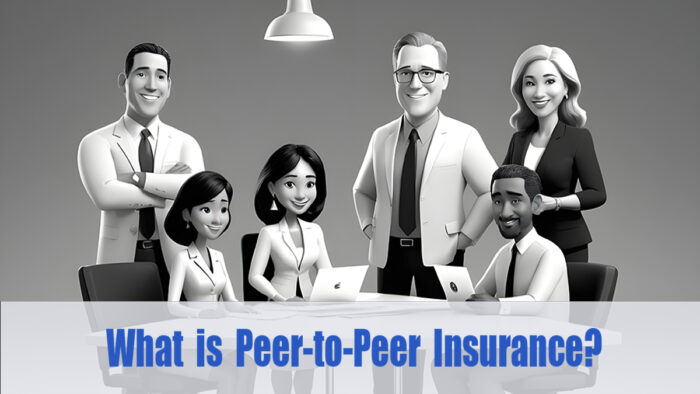Over the years, traditional insurance has been criticized for its inefficiency, lack of transparency, and complexity. Hence the emergence of a new type of insurance: peer-to-peer insurance.

This type of insurance promises to revolutionize the insurance industry by providing coverage for a wide range of risks.
Peer-to-peer insurance is a product that features a collaborative approach to risk-sharing. It allows individuals to pool their resources in order to provide coverage for various risks.
What is Peer-to-Peer Insurance?
Peer-to-peer insurance is designed for people who share common goals and interests. It uses a similar model as mutual insurance companies, where the policyholders tend to have greater control over the decision-making process of the insurance. It can also be likened to a form of self-insurance whereby the members determine how premiums are used and control how losses are covered.
The primary aim of P2P insurance is to streamline the insurance process, reduce administrative costs, and promote transparency and solidarity among group members.
An example of P2P insurance is the Health Care Sharing Ministry (HCSM), where individuals with similar faith and ethical beliefs provide financial support for each other’s medical costs.
How Peer-to-Peer Insurance Works
In a typical peer-to-peer insurance setting, members of a community work hand in hand to form a risk-sharing pool, where each person makes a contribution of a certain amount of money into the pool. This money will then be used to cater for claims made by other members.
The primary aim of P2P insurance is to minimize the financial burden on a single member through the provision of coverage for a wide range of risks.
This type of insurance emphasizes peer governance and decision-making by members who recognize the importance of working together to assess and adjudicate claims.
This participatory approach fosters a sense of ownership, transparency, and accountability, as well as ensuring the fair and timely resolution of claims by group members.
What It Covers
Peer-to-peer insurance embodies a wide range of policies. Under this type of insurance, there’s the inclusion of:
- Property insurance
- Health insurance
- Cyber insurance
- Small business insurance
- Renters insurance
- Auto insurance
- Home insurance
- Pet insurance
- Travel insurance
- Life insurance
- Liability insurance
What It Does Not Cover
Despite the fact that P2P insurance offers a wide range of policies, it may not cover certain types of risks. Some of which include;
- Catastrophic events due to natural disasters like earthquakes or floods.
- Intentional acts of harm or illegal activities
- Pre-existing conditions, as in health insurance
- Certain high-risk activities
- Commercial activities are not covered by small business insurance.
- Acts of war or terrorism
- Damage caused by wear and tear or a lack of maintenance
- Losses covered by other insurance policies held by the insured individual.
There may also be other types of exclusions outlined in the policy terms and conditions of the insurance provider. So it is essential to carefully review them.
Advantages of Peer-to-Peer Insurance
Peer-to-peer insurance offers a wide range of benefits, which makes individuals adopt it over traditional insurance models. Highlighted below are some of the advantages of P2P insurance:
- Low Premiums: This is one of the primary benefits of peer-to-peer insurance, making it more affordable and accessible to all. Through the elimination of profit-driven intermediaries and a reduction in administrative overhead, P2P insurance offers lower premiums and competitive rates to its members.
- Promotes a Sense of Solidarity: This insurance promotes a greater sense of solidarity among participants. Individuals with shared interests and common experiences are connected through mutual support and collaboration. Peer-to-peer insurance is a platform that gives a sense of belonging and unity. This can come in handy in times of crisis or hardship, when members rely on the collective strength of members to overcome certain challenges.
- Transparency and Accountability: This is another advantage of P2P insurance that provides visibility and accounts for all the operations it carries out. Unlike traditional insurance, which may operate behind closed doors, P2P insurance provides members with insights into the insurance process and other inner workings, thus promoting transparency. This helps to build trust and confidence among participants.
Disadvantages of Peer-to-Peer Insurance
Although P2P insurance holds great promise in the insurance industry, there are certain changes and limitations. Some of its challenges include:
- Moral Hazard: This is one of the primary challenges facing P2P insurance today. This insurance has the potential for adverse selection and moral hazards because it does not include proper guidelines that ensure the smooth running of its activities. Individuals may engage in risky activities that will automatically lead to collective responsibility for an action by just one individual.
- Apathy Exhibited by Participants: We all know the success of P2P insurance relies greatly on the willingness of participants to engage in the risk-sharing process. Some members may decide to exhibit apathy and not take an active part in monitoring the pool, assessing claims, and enforcing rules, ultimately creating room for disunity and compromise of integrity.
- Regulatory and Legal Considerations: This is also one of the significant hurdles facing peer-to-peer insurance, making it less adoptable nationwide. Owing to the fact that insurance is a highly regulated industry, P2P insurance platforms must confirm the regulations governing insurance operations.
It’s always important to compare the advantages with the disadvantages. When you do this, you can make an informed decision.


